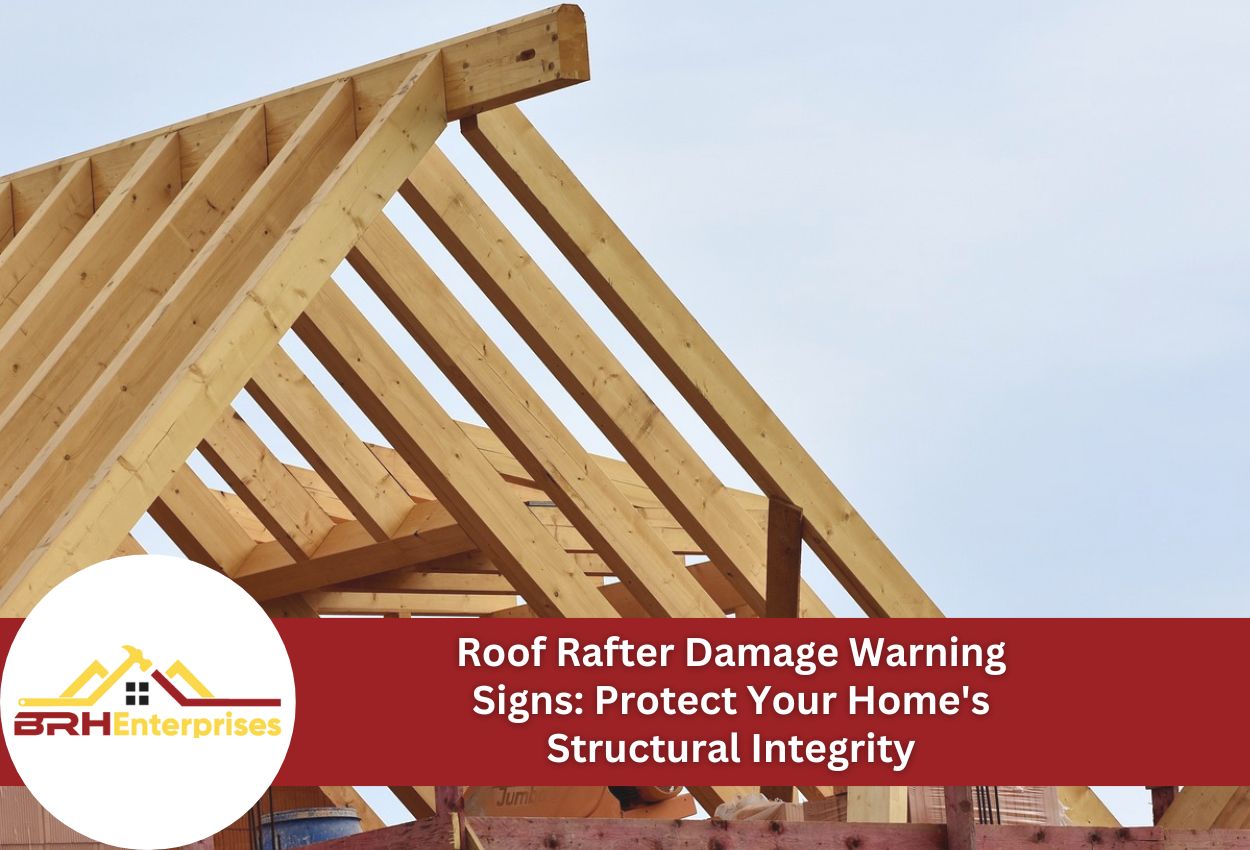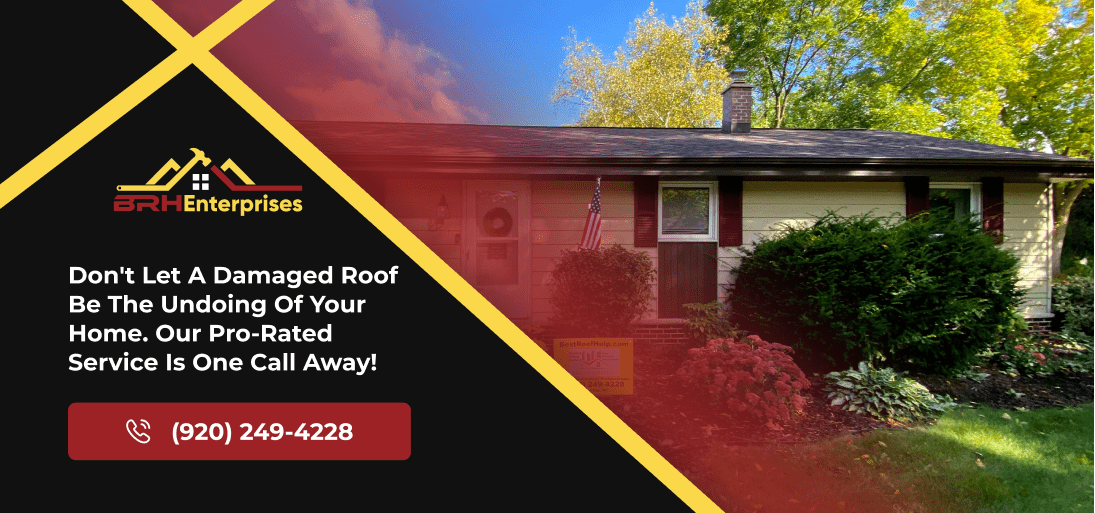Roof Rafter Damage Warning Signs: Protect Your Home’s Structural Integrity
Estimated Reading Time : 6 Min.

Roof rafters are the backbone of your home’s structure. These essential wooden beams extend from the ridge or upper point of your roof down to the exterior walls, creating the framework that supports your entire roofing system. Rafters distribute the weight of your roof evenly across your home’s structure, protecting everything beneath it from the elements.
For Wisconsin homeowners, the threat to roof rafters is particularly serious due to our extreme seasonal weather conditions. Heavy snow loads during harsh winters, spring thaws, summer storms, and fall moisture can all contribute to the gradual weakening of these critical structural components. When rafters begin to fail, they put your entire home at risk.
Detecting roof rafter damage early is not just about preventing leaks — it’s about preserving the stability of your entire home. Compromised rafters can lead to sagging ceilings, warped walls, and in severe cases, partial roof collapse. The danger increases with each passing season as damaged rafters continue to deteriorate under weather pressure.
Understanding the warning signs of roof rafter damage means homeowners can take action before a minor issue becomes a major structural crisis. Recognizing these symptoms early can mean the difference between a simple repair and a complete roof rebuild. This guide will get into five signs of rafter damage that every homeowner should know.
Sign #1: Visible Sagging and Deformation in Your Ceiling
Your ceiling often serves as the first visible indicator of serious problems with the roof rafters above. When you notice a ceiling that’s no longer perfectly flat, it’s time to pay attention. Look for gentle waves, visible drooping in the center of rooms, or areas where the ceiling appears to be sinking. These deformations aren’t just cosmetic issues — they signal that the rafters supporting your roof may be failing to bear their load properly.
Uneven surfaces might appear subtly at first, with slight dips that become more pronounced over time. Check along wall-ceiling junctions for gaps or unusual angles that weren’t there before. In Wisconsin homes, where snow adds significant weight on roofs during winter, even minor sagging can rapidly worsen with each freeze-thaw cycle.
If you spot water stains accompanying these deformations, the situation is even more urgent. This combination likely indicates that moisture has penetrated your roof structure, potentially causing wood rot in the rafters. Structural problems often manifest as sticking doors, cracked drywall, or visible gaps between walls and ceilings.
Regular visual inspections of your ceiling surfaces should be part of every Southern Wisconsin homeowner’s maintenance routine. Being vigilant about these interior warning signs can help you address roof rafter issues before they compromise your home’s structural integrity.
Sign #2: Water Stains and Moisture Damage
Water stains on your ceiling or attic surfaces are clear indicators that moisture has penetrated your roof system and potentially damaged your rafters. These stains typically appear as yellowish or brownish discoloration, often in circular or irregular patterns. When examining your attic, look for dark streaks along rafters or damp spots that feel soft when pressed. These are telltale signs that moisture has compromised the wood’s integrity.
Wisconsin’s climate creates particularly challenging conditions for roof structures. The repeated freeze-thaw cycles we experience accelerate moisture damage in several ways. When water seeps into tiny cracks in rafters, it expands upon freezing, widening these gaps. As temperatures warm, the ice melts, allowing water to penetrate deeper into the wood before the next freeze. This cycle creates ideal conditions for wood rot and structural weakening.
Mold growth accompanying water stains is another serious concern. Look for fuzzy or discolored patches on wood surfaces, which indicate both moisture and potential health hazards. Black or greenish growth on rafters suggests long-term exposure to dampness that can gradually turn solid wood into spongy, compromised material.
Regular inspections of your attic space, particularly after heavy rain or snowmelt, can help identify these moisture patterns before they cause catastrophic structural failure. Remember that water doesn’t always drip directly downward, it often travels along rafters before collecting at low points.
Sign #3: Cracking Sounds and Unusual Noises From Your Attic
If your home starts to creak, pop, and crack, it’s sending important signals about your roof’s structural health. These sounds aren’t just normal house settling, especially when they become more frequent or intense. Sharp cracking noises often indicate wood fibers separating under stress, while prolonged creaking suggests rafters are bending beyond their tolerance limits. A sudden snap could mean a rafter has fractured or failed completely.
The timing of these sounds provides valuable diagnostic information. Noises that increase during temperature fluctuations may indicate expanding and contracting wood that’s compromised by moisture damage. Sounds that intensify after snowfall or heavy rain suggest your rafters are struggling with additional weight, which is a serious concern for Southern Wisconsin homeowners facing our substantial winter snow loads.
Investigating attic noises requires caution. Wait until daylight hours and bring a flashlight to examine rafter connections. Look for visible gaps, splits along wood grain, or areas where rafters meet the ridge beam that appear misaligned. Listen for continuing noises while safely standing on floor joists. If you detect structural roof damage symptoms or feel uncomfortable with the inspection, contact a professional roofer immediately.
Wisconsin homeowners should be especially vigilant after storms or heavy snowfall, as these events can transform borderline roof beam deterioration into urgent structural failures. Prompt attention to unusual attic sounds can prevent catastrophic damage and ensure your home remains safe through all seasons.
Sign #4: Visible Rafter Deterioration
A thorough attic inspection can reveal rafter damage before it threatens your home’s structural integrity. When examining your attic, always use a stable ladder, wear protective gear, and ensure adequate lighting. Start by visually scanning rafters for obvious signs of trouble like cracks running along the grain, splits at connection points, or any warping or bowing in what should be straight beams.
Physical deterioration often appears as soft, spongy areas in what should be solid wood. Test suspicious spots by gently pressing with a screwdriver (not piercing) — healthy wood resists pressure while damaged areas feel soft or crumbly. Pay special attention to areas where rafters connect to the ridge beam or exterior walls, as these junctions often show the first signs of failure.
Insect damage manifests as small holes, tunneling patterns, or sawdust-like frass beneath rafters. In Wisconsin attics, look specifically for carpenter ant or beetle damage, which can severely compromise wood strength. Fungal growth appears as discoloration ranging from white fuzzy patches to black spotting or even mushroom-like growths on severely rotted wood. The presence of a musty smell often accompanies fungal issues.
If you discover any of these warning signs during your inspection, don’t delay contacting a qualified roofing professional. Deteriorated rafters in your Southern Wisconsin home will only worsen with each passing season of moisture exposure.
Sign #5: Exterior Signals That Point to Rafter Problems
While many rafter issues first appear inside your home, the exterior of your roof often displays clear warning signs of structural problems developing beneath. A sagging roof ridge line is one of the most obvious indicators. When viewed from the street, your roof should present a straight, level ridge at its peak. Any dipping, waviness, or visible depression along this line suggests the rafters supporting it have weakened or failed.
Examine your shingle pattern carefully for irregularities. Areas where shingles appear buckled, warped, or dipped inward often correspond to weakened rafters underneath. In older Southern Wisconsin homes, you might notice a “roller coaster” effect along roof edges or uneven spacing between roof elements that were once symmetrical.
Wall separation is another critical warning sign. Check where exterior walls meet roof overhangs for gaps or unusual angles. Doors and windows that suddenly stick or fail to close properly might indicate your home’s frame is shifting due to compromised roof support. Cracks appearing in exterior brickwork or siding, especially near the roofline, often develop when rafters no longer properly distribute weight.
After heavy snowfall, watch for uneven snow melt patterns on your roof. Areas where snow melts faster or slower than surrounding sections may indicate heat escaping through structural gaps or insulation compressed by damaged rafters. Wisconsin homeowners should be particularly vigilant after winter storms that place substantial weight on roof structures.
Professional Assessment and Smart Repair Decisions
Knowing when to handle roof issues yourself vs. calling a professional is crucial when facing potential rafter damage. While minor maintenance tasks like clearing gutters or replacing a few shingles can be DIY projects, any signs of structural compromise warrant expert attention. Wisconsin roofing specialists have the training and equipment to safely assess rafter damage and determine the extent of deterioration that might not be visible to untrained eyes.
Professional roofers can identify whether your roof structure requires simple reinforcement, partial rafter replacement, or complete structural rebuilding. They’ll evaluate not just the visible damage but also adjacent areas that might be compromised but not yet showing symptoms. This comprehensive assessment prevents the common mistake of treating superficial issues while missing underlying structural weaknesses.
Preventive maintenance plays a key role in extending your roof’s structural lifespan. Regular professional inspections can identify small issues before they become major structural problems. A qualified Wisconsin roofing contractor can recommend targeted preventative measures such as improving attic ventilation, addressing moisture sources, or reinforcing specific rafters showing early signs of stress. These proactive approaches often cost significantly less than emergency repairs and help maintain your home’s value and safety.
When evaluating repair options, consider both immediate solutions and long-term prevention. The most cost-effective approach often addresses not only the damaged rafters but also the underlying conditions that caused the deterioration in the first place.
Protect Your Home with Expert Rafter Repair from BRH Enterprises LLC
If you’ve noticed any of the warning signs of roof rafter damage, it’s crucial to act swiftly to prevent further damage to your home. Wisconsin’s harsh weather conditions can worsen roofing issues, leading to more severe structural problems if left unaddressed.
Call BRH Enterprises LLC today at (920) 249-4228 for a professional assessment of your roof’s condition. Our experienced team can provide you with the best solutions to maintain the longevity and safety of your roof. Protect your investment and peace of mind by choosing BRH Enterprises LLC for all your roofing needs.


